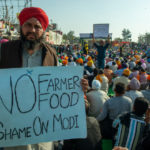The various forces of Indian labour, despite their contradictions, have shown their power in the face of the rightwing BJP regime — Editors
The General Strike called by all the major Central Trade Unions on the 28th and 29th of March in India was an extremely successful one. Almost all the trade unions in the major sectors in the country participated in the demonstrations, which concluded late in the day on the 29th of March. The primary demands raised by the unions were focused upon the need to resist the anti-people and pro-market policies of the Modi government. The demands by unions varied in accordance with the different trade unions and the sectors in which they functioned within. For example, the insurance employees emphasised the need to resist the privatisation of India’s insurance sector which largely caters to a huge chunk of the population that remains incapable of availing private insurance facilities, while the Anganwadi (Care workers) workers focused on the need to recognise their labour as ‘labour’ and accept them as parts of the country’s workforce. The major participants in the strike were unions associated with the All India Trade Union Congress (AITUC), the Centre of Indian Trade Unions (CITU), the All India Central Council of Trade Unions (AICCTU), Trade Union Congress of India (TUCI), Indian Federation of Trade Unions (IFTU), etc. The trade unions affiliated with the Sangh Parivar, and mostly led by the Hindu nationalist Bhartiya Mazdoor Sangh (BMS), however, stayed clear of the strike and did not support the general strike.
The strike took place at an important political juncture where the economy of the country has been going through a crisis, the ramifications of which have been amplified by the continued attacks on the workers’ rights. The labour codes which the Hindu nationalist Bharatiya Janata Party (BJP) government passed concurrently in an undemocratic manner along with the infamous farm laws – which it had to repeal because of the valiant Farmers’ Movement – form the basic crux of the recent attack on workers’ rights in the country.
The increasing contractualisation and casualisation of previously permanent positions in important sectors of the country has left the workers in a position where their daily lives have been left at the mercy of the market. The government has also, at the same time, been engaged in a continuous effort to privatise important parts of the country’s formal sector which includes insurance and banking. This was one of the major rallying cries from unions such as All India Insurance Employees Association (AIIEA) and All India Bank Employees Association (AIBEA). Other trade unions such as the Self Employed Women’s Association (SEWA) brought forward the dismal effects that the labour codes and increasing corporatisation of the economy would begin to have on women in the labour force. The demonstrations in different parts of the country focused on the ways in which the BJP–ruled central government and state governments have been implementing laws and regulations which have been going against the welfare of the common workers in the country. Along with the public sector employees, the private sector workers also participated in the strike. Unions operating within the IT sector of the country protested in various cities bringing out the inhuman conditions within which the companies, focused on garnering a work from home culture in the country, made their employees work in. Major corporates have recently begun to indulge in practices such as rapid institutionalisation of the hire–and–fire regime, which would result in further intensifying the dehumanisation of the workforce engaged with them. It is worthwhile to note at this point that it is this policy that the new labour codes want to render mainstream in all the different sectors in the country.
Almost all the different unions engaged in the strike argued in favour of the need to protect the rights to unionisation by the workers in different sectors, something which the new labour codes attack vehemently.
The strike also had scope for improvement. For example, there was little participation by the gig workers, a sector in which most trade unions have only recently begun to focus on. Gig workers constitute one of the sectors which is increasingly composed of a highly precariat workforce, along with domestic workers – both of which have had little involvement in the strike. At the same time, there were also issues where some trade unions (for example those led by the Communist League of India), especially those affected by narrow sectarianism of their political vanguards, stayed clear of strike action on the two days.
Simultaneously, even with the shortcomings, the strike also brought forward the effect which a united working-class movement overcoming political barriers could potentially have on the mainstream politics in the country. The important point which needs to be focused on at this critical juncture of the Indian workers’ movement is the way that the central trade unions related the questions of wage struggles to the growing anti-democratic nature of the neo-fascist BJP regime.
However, that being said, it also remains to be seen the methods through which they address the quintessential question of the dialectical relationship between spontaneous movements of the marginalised sections – like the one taken up by the farmers – and the planned revolutionary procedural activities such as the 2-day general strike. Failing which, the incessant struggle which needs to be put up against the anti-worker policies such as the labour codes will only remain a distant utopia.






0 Comments